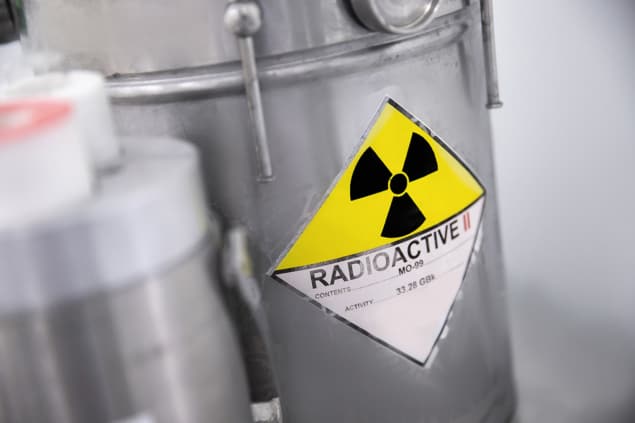Technetium-101: from impurity to multipurpose medical tool
15 Oct 2021
Edward Mausolf and Erik Johnstone, partners at Innovative Fuel Solutions LLC, frame their vision as one of necessity. Ten years ago, they were in graduate school becoming technetium chemistry experts, and as they studied how isotopes of technetium could be produced and separated, they realized that there were issues inherent in the technetium supply chain that the industry would continue to face unless substantial changes were made.
Technetium-99m (Tc-99m), the single most-used isotope for nuclear diagnostic imaging procedures, for example, is typically produced from molybdenum-99 (Mo-99) using nuclear reactors. Scientists can’t produce a stockpile of Mo-99/Tc-99m due its relatively short physical half-life (the amount of time it takes an isotope to decay to half of its initial activity); instead, they must produce and distribute it continuously. Other issues, such as aging nuclear reactor infrastructure and the increasing demand for radioisotopes, have contributed to several major interruptions in the Mo-99/Tc-99m supply chain over the years.
Simply put: there’s a need for new methods that can produce radioisotopes of technetium more efficiently and with less waste.
Mausolf and Johnstone have since devised a method that relies on deuterium–deuterium neutron generators to produce radioisotopes of technetium. Their approach could solve supply chain and infrastructure issues by safely bringing the production of Tc-99m and the previously underutilized radioisotope Tc-101 closer to a patient’s bedside, while also generating less waste and using fewer resources. Results of their initial experiments, reported in the journal Pharmaceuticals, also suggest that Tc-101 – often considered to be an impurity – could be useful in medical imaging and therapy applications.
Producing technetium isotopes with a neutron generator
“We realized that there might be some out-of-the-box thinking, ideas as a way to manipulate time in order to increase yield. Instead of having a larger pile, use different isotopic ratios of technetium, to be able to make up the difference of the inefficiencies of the current supply chain,” says Mausolf. “And a neutron generator makes sense because you don’t have long-lived fission waste.”
Deuterium–deuterium neutron generators create neutron radiation by colliding isotopes of hydrogen called deuterium. When two deuterium atoms collide in a fusion reaction, they create free neutrons that can collide with a molybdenum target to produce isotopes of technetium. When neutrons bombard a molybdenum target, Tc-101 is produced alongside Tc-99m. And Johnstone and Mausolf want to put Tc-101 to work. Though its half-life is only 14.22 min, Tc-101 produces beta (487 keV, 90.3%) and gamma (307 keV, 89.4%) rays when it decays. These could be harnessed for both therapeutic and imaging applications.
“We believe that small-scale radioactive isotope production close to the point of use could be the way forward because it avoids the need to ship fast-decaying products with half-lives measured in hours across the country or even internationally,” Johnstone adds. “Another key feature of our research was pinpointing the production or isolation of Tc-101, which we see as a shorter-lived isotope of technetium that’s not discussed in the literature.”
The scientists say that Tc-101’s short physical half-life should not deter others from considering its medical applications because other isotopes with even shorter half-lives, such as oxygen-15, which has a half-life of just over 2 min, are widely used.
Instead, Mausolf and Johnstone say that the biggest challenge they faced was optimizing the production of Tc-101 from neutrons produced using a deuterium–deuterium neutron generator. Compared with deuterium–tritium neutron generators (which are more powerful, but require increased shielding and regulatory burden due to tritium’s radioactivity), a deuterium–deuterium neutron generator often produces fewer neutrons that also have lower energies, which reduces the amount of a radioisotope that can be produced.
With the goal of increasing Tc-101 yield, the scientists partnered with David Williams at Adelphi Technology. Together, they devised and coupled an optimized separation process to Adelphi’s deuterium–deuterium neutron generators, which produce neutron yields exceeding 10 billion neutrons per second. Neutrons produced in the generator then hit molybdenum, which in turn decays to Tc-99m and Tc-101. The resulting material is contacted with activated carbon to isolate the technetium isotopes from the remaining bulk, low specific activity molybdenum.
With the optimized system, “you always have some equilibrium period in production,” says Williams. “You have a half-life that’s not a half-life because it’s dominated by that of the parent [molybdenum].”
Additional considerations
The scientists evaluated the yields of Tc-99m and Tc-101 produced with this method and compared yields to those from a deuterium–tritium system as well as natural and enriched molybdenum targets. And though their purpose was not to pinpoint any specific applications of Tc-101, they also considered the impact of producing the isotope from environmental, financial, regulatory and clinical perspectives.READ MORE

Natalia Mayordomo, a scientist from the HZDR Institute of Resource Ecology who consulted on the study, notes that because of the short physical and biological half-life of Tc-101 and its stable daughter product, ruthenium-101, the amount of radioactive material entering the environment through human waste will be less than that from radioisotopes with longer-lived ground states or decay products.
In addition, says Williams, neutron generator targets have low specific activity, there are no fission products associated with radioisotope production, and shielding requirements wouldn’t be much different to shielding PET isotopes like fluorine-18.
The team’s next steps including raising funding for a pilot production line and scaling up production so that important studies in mice and testing by regulatory agencies such as the US Food and Drug Administration can begin.
Producing isotopes of technetium using a deuterium–deuterium neutron generator and considering new uses for “impurities” like Tc-101 “present a large dynamic change to the argument of how to make technetium work for the medical community,” says Mausolf. “I think it’s got a lot of traction, I think there’s a lot of runway, and I think there’s a lot more to come.”
Catherine Steffel is a science writer based in Madison, Wisconsin. Catherine was previously a PhD student contributor to Physics World.
from physicsworld.com 20/10/2021

Δεν υπάρχουν σχόλια:
Δημοσίευση σχολίου